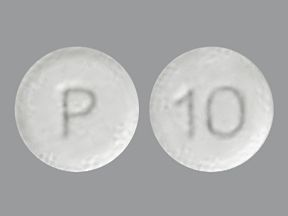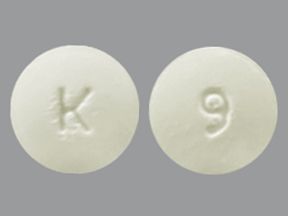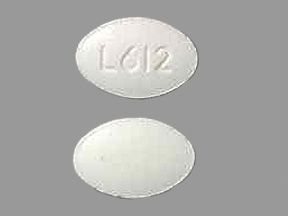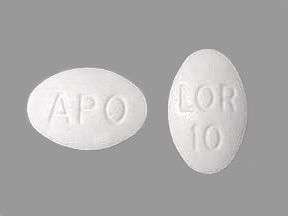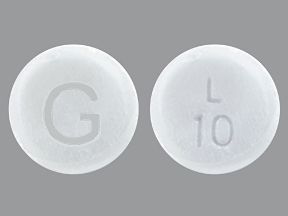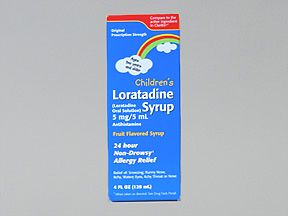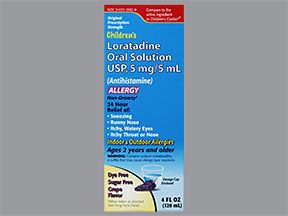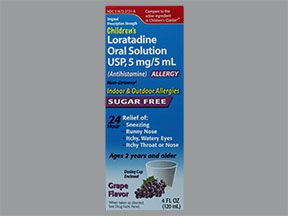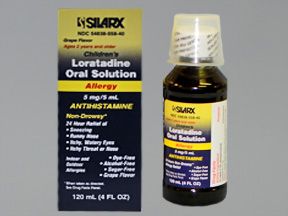If you have allergies, your doctor or pharmacist may recommend taking loratadine. It’s a generic drug that you can buy over the counter, which means you don’t need a prescription.
Loratadine is used in adults and certain children to treat upper respiratory allergies, such as hay fever or pet allergies. Loratadine can relieve symptoms of these allergies, such as:
- runny nose
- sneezing
- itchy nose or throat
- itchy, watery eyes
Loratadine basics
Loratadine belongs to a group of drugs called antihistamines.
Loratadine comes as a tablet that you swallow. It’s also available as a capsule, liquid solution, and dissolving tablet, but those are not covered in this article.
Read on to learn more about loratadine’s uses, side effects, and other important information.
Loratadine brand-name versions
Loratadine is a generic drug, which means it’s an exact copy of the active drug in a brand-name medication. The brand-name medication that loratadine is based on is called Claritin.
Generic drugs are thought to be as safe and effective as the brand-name drug they’re based on. In general, generics usually cost less than brand-name drugs do.
If you’d like to know more about taking Claritin instead of loratadine, talk with your doctor. And explore this Healthline article to learn more about the differences between generic and brand-name drugs.
The information below describes the loratadine dosage that’s commonly used or recommended. If you’re unsure about what dosage to take, ask your doctor or pharmacist.
Form
Loratadine comes as a tablet that you swallow.
Strength: 10 mg
The loratadine tablet is available in one strength of 10 milligrams (mg).
Recommended dosages
The usual loratadine dosage for adults is 10 mg taken once per day.
The usual dosage for children ages 6 years and older is 10 mg taken once per day.
The maximum dosage for adults and children taking loratadine is 10 mg in 24 hours.
Questions about loratadine’s dosage
Below are some common questions about loratadine’s dosage.
- Will I need to use loratadine long term? You should take loratadine only when needed to relieve your allergy symptoms. How long you need to take loratadine depends on what causes (or triggers) your allergy symptoms. For example, if you’re allergic to cats, you might take loratadine for a few days while visiting a friend with a cat. But if you’re allergic to grass pollen, you might want to take loratadine throughout the spring and summer.
- How long does loratadine take to work? Loratadine usually starts working about 1 hour after you take a dose.
Like most drugs, loratadine may cause mild or serious side effects. The lists below describe some of the more common side effects that loratadine may cause. These lists don’t include all possible side effects.
Keep in mind that side effects of a drug can depend on:
- your age
- other health conditions you have
- other medications you take
Your doctor or pharmacist can tell you more about the potential side effects of loratadine. They can also suggest ways to help reduce side effects.
Mild side effects
Here’s a short list of some of the mild side effects that loratadine can cause. To learn about other mild side effects, talk with your doctor or pharmacist.
Mild side effects of loratadine that have been reported include:
- headache
- diarrhea
- drowsiness
- dry mouth
- fatigue (low energy)
- mild allergic reaction*
Mild side effects of many drugs go away within a few days to a couple of weeks. But if they become bothersome, talk with your doctor or pharmacist.
* To learn more about this side effect, see the “Allergic reaction” section below.
Serious side effects
Serious side effects from loratadine can occur, but they aren’t common. If you have serious side effects from loratadine, call your doctor right away. But if you think you’re having a medical emergency, you should call 911 or your local emergency number.
Serious side effects of loratadine that have been reported include severe allergic reactions.To learn more about this side effect, see the “Allergic reaction” section below.
Allergic reactionSome people may have an allergic reaction to loratadine. Although allergic reaction wasn’t reported in studies of loratadine, it can still happen.
Symptoms of a mild allergic reaction can include:
A more severe allergic reaction is rare but possible. Symptoms of a severe allergic reaction can include swelling under your skin, usually in your eyelids, lips, hands, or feet. They can also include swelling of your tongue, mouth, or throat, which can cause trouble breathing.
Call your doctor right away if you have an allergic reaction to loratadine. But if you think you’re having a medical emergency, call 911 or your local emergency number.
Find answers to some commonly asked questions about loratadine.
How does loratadine compare with other similar drugs, such as cetirizine?
Loratadine belongs to a group of drugs called antihistamines. Other antihistamines available for treating allergies include:
- cetirizine (Zyrtec)
- fexofenadine (Allegra)
- diphenhydramine (Benadryl)
- desloratadine (Clarinex)
Most antihistamines are similarly effective, but you may find that one works better for you than another.
Your doctor or pharmacist may recommend a certain antihistamine depending on the symptoms you have. For example, loratadine is typically recommended for upper respiratory symptoms. Other antihistamines may be suggested for treating itching associated with hives or skin allergies.
Some antihistamines cause drowsiness. For example, diphenhydramine commonly causes drowsiness. When taken as directed, loratadine, fexofenadine, and cetirizine usually cause much less drowsiness.
To learn more about how loratadine compares with other antihistamines, talk with your doctor or pharmacist. They can help you decide which medication may be best for you.
Will loratadine make me drowsy or raise my blood pressure?
No, loratadine doesn’t usually cause these side effects.
Most people don’t feel drowsy or sleepy while taking loratadine as directed. But some people have reported mild drowsiness while taking loratadine.
High blood pressure has been reported with loratadine. It’s unknown how often this occurs, but it’s likely rare.
Can I take a 5-mg or 20-mg dose of loratadine?
No, with loratadine tablets, you should not take a 5-milligram (mg) or 20-mg dose.
The maximum recommended dosage of loratadine is 10 mg in 24 hours. Taking a higher dose of loratadine, such as 20 mg, may cause an antihistamine overdose or increase your risk of side effects.
The usual loratadine dosage is 10 mg taken once per day. A 5-mg dose of loratadine is probably not enough to relieve your allergy symptoms. Also, these tablets only come in a 10-mg strength. They’re not scored and not meant to be split in half.
For children ages 2 to 5 years, other forms of loratadine that are easier to take are available at lower doses. But loratadine tablets should not be used in children younger than 6 years old.
Is loratadine used for dogs?
Yes, veterinarians sometimes prescribe loratadine to treat allergies in dogs. But this is an off-label use for loratadine. (Off-label use refers to using a drug for a purpose that the FDA has not approved.)
You should not give loratadine to your dog unless your veterinarian has prescribed it. Your veterinarian can tell you more about using loratadine in pets.
Does loratadine cause long-term side effects?
No, loratadine isn’t known to cause any long-term side effects. It’s generally considered safe to take this drug long term.
If you’re concerned about long-term side effects with loratadine, talk with your doctor or pharmacist.
Can loratadine be used for cough or hives?
It depends. Loratadine is approved to treat upper respiratory allergies, such as hay fever. But in some cases, it can be used for symptoms of cough or hives.
Some people have a tickly cough with allergies, such as hay fever. The cough is caused by postnasal drip (mucus running down the back of your throat). Loratadine dries up the mucus in your nose, so it can help ease this type of tickly cough. But it’s unlikely to treat other causes of cough.
Loratadine isn’t typically used for skin allergies, such as hives. But antihistamines, such as loratadine, can relieve itching from hives. A brand-name form of loratadine called Claritin Hives Relief is one drug used to treat itching from hives.
Sometimes, doctors will prescribe loratadine with a stronger antihistamine that’s approved to treat hives, such as diphenhydramine (Benadryl). But if you want to take loratadine for hives, always talk with your doctor or pharmacist first.
There are a few things to consider before taking loratadine. The medication may interact with other conditions you have, other medications you take, and certain tests you may have. You should talk with your doctor or pharmacist about your health history and other treatments before taking loratadine.
Some things to consider are discussed below.
Interactions
Taking a medication with certain vaccines, foods, and other things can affect how the medication works. These effects are called interactions.
Before taking loratadine, be sure to tell your doctor or pharmacist about all medications you take (including prescription and over-the-counter types). Also, describe any vitamins, herbs, or supplements you use. Your doctor or pharmacist can tell you about any interactions these items may cause with loratadine.
For information about drug-condition interactions, see the “Warnings” section below.
Interactions with drugs or supplements
Loratadine doesn’t usually interact with other medications. But you may be more likely to feel drowsy or sleepy if you take it with other drugs that make you feel sleepy. Examples of these drugs include:
- sleeping pills
- some anxiety drugs
- sedating antihistamines, such as diphenhydramine (Benadryl)
- certain strong pain relievers
Loratadine should not be taken with other antihistamines unless your doctor prescribes the combination. (Loratadine is an antihistamine.)
This list does not contain all types of drugs that may interact with loratadine. Your doctor or pharmacist can tell you more about these interactions and any others that may occur when taking loratadine.
Other interactions
Loratadine can affect the results of allergy tests, such as skin tests you may have to check for certain allergies.
If you’re planning to have an allergy test done, your doctor will likely recommend that you do not take loratadine for a few days beforehand.
Warnings
Loratadine can sometimes cause harmful effects in people who have certain conditions. This is known as a drug-condition interaction. Other factors may also affect whether loratadine is a good treatment option for you.
Talk with your doctor about your health history before you take loratadine. Factors to consider include those described below.
Liver or kidney problems. Your liver and kidneys help remove loratadine from your body. If your liver or kidneys don’t work well, loratadine could build up in your body. This could raise your risk of side effects. If you have a liver or kidney problem, talk with your doctor before taking loratadine. They may recommend taking a dose every other day instead of every day.
Allergic reaction. If you’ve had an allergic reaction to loratadine or any of its ingredients, your doctor will likely recommend that you do not take loratadine. Ask them what other medications are better options for you.
Loratadine and alcohol
Loratadine isn’t known to interact with alcohol. But alcohol and loratadine can cause some of the same side effects, such as headache and fatigue (low energy). Combining alcohol and loratadine may raise your risk of having these side effects or may make them worse if you experience them.
Although loratadine doesn’t usually cause drowsiness, you may be more likely to feel drowsy if you drink alcohol while taking it.
If you drink alcohol, talk with your doctor about how much is safe to drink with loratadine.
Pregnancy and breastfeeding
It’s not known if loratadine is safe to take during pregnancy. If you’re pregnant or planning to become pregnant, talk with your doctor before taking loratadine.
It’s also not known if loratadine is safe to take while breastfeeding. Loratadine can pass into breast milk. But it’s not known how this drug may affect a breastfed child. If you’re breastfeeding or planning to breastfeed, talk with your doctor before taking loratadine.
Loratadine is used to treat the symptoms of upper respiratory allergies, such as hay fever.
Allergies occur when your immune system overreacts to a harmless substance. For example, your body may react to tiny particles you breathe in from the air, including:
- grass or tree pollen
- mold spores
- pet dander (skin flakes)
- dust mite waste
When this happens, cells in your immune system release histamine. Histamine causes inflammation. This leads to allergy symptoms, such as:
- runny nose
- sneezing
- itchy nose or throat
- itchy, watery eyes
Loratadine is an antihistamine. It relieves allergy symptoms by stopping histamine from acting on cells that cause inflammation.
You should not take more than 10 mg of loratadine in 24 hours. And you should not take loratadine with other antihistamines unless your doctor specifically prescribes them together. (Loratadine is an antihistamine.) Taking too much loratadine or more than one antihistamine at a time when you’re not directed to can cause an antihistamine overdose.
What to do in case you take too much loratadine
Call your doctor if you think you’ve taken too much loratadine. You can also call 800-222-1222 to reach the American Association of Poison Control Centers or use its online resource. But if you have severe symptoms, immediately call 911 or your local emergency number. Or go to the nearest emergency room.
Your doctor or pharmacist will explain how you should take loratadine. They’ll also explain how much to take and how often. Be sure to follow your doctor or pharmacist’s instructions.
Taking loratadine
Loratadine comes as a tablet that you swallow. You’ll take it once per day as needed to relieve allergy symptoms.
You should not take more than one dose in 24 hours.
Accessible medication containers and labels
If it’s hard for you to read the label on the medication, tell your doctor or pharmacist. Certain pharmacies provide medication labels that:
- have large print
- use braille
- contain a code you can scan with a smartphone to change the text to audio
Your doctor or pharmacist may be able to recommend a pharmacy that offers these options if your current pharmacy doesn’t.
Questions about taking loratadine
Below are some common questions about taking loratadine.
- Can loratadine be chewed, crushed, or split? Loratadine tablets are meant to be swallowed whole. If you have trouble swallowing loratadine tablets, talk with your doctor or pharmacist. Other forms of loratadine are available that may be easier for you to take.
- Should I take loratadine with food? You can take loratadine either with or without food.
- Is there a best time of day to take loratadine? No, you can take loratadine at any time of day. But if you’re taking it for more than 1 day, it’s best to take it around the same time each day. This helps the medication work effectively.
Prescription drug costs can vary depending on many factors. These factors include what your insurance plan covers and which pharmacy you use.
Financial assistance to help you pay for loratadine may be available. Medicine Assistance Tool and NeedyMeds are two websites that provide resources to help reduce the cost of loratadine.
These websites also offer tools to help you find low cost healthcare and certain educational resources. To learn more, visit their websites.
If you have questions about taking loratadine, talk with your doctor or pharmacist. Some examples of questions you may want to ask include:
- How effective is loratadine?
- Can I take loratadine to prevent allergies?
- How long should I take loratadine?
- Can I take loratadine with other allergy treatments?
To get information on different conditions and tips for improving your health, subscribe to any of Healthline’s newsletters. You may also want to check out the online communities at Bezzy. It’s a place where people with certain conditions can find support and connect with others.
Disclaimer: Healthline has made every effort to make certain that all information is factually correct, comprehensive, and up to date. However, this article should not be used as a substitute for the knowledge and expertise of a licensed healthcare professional. You should always consult your doctor or another healthcare professional before taking any medication. The drug information contained herein is subject to change and is not intended to cover all possible uses, directions, precautions, warnings, drug interactions, allergic reactions, or adverse effects. The absence of warnings or other information for a given drug does not indicate that the drug or drug combination is safe, effective, or appropriate for all patients or all specific uses.

